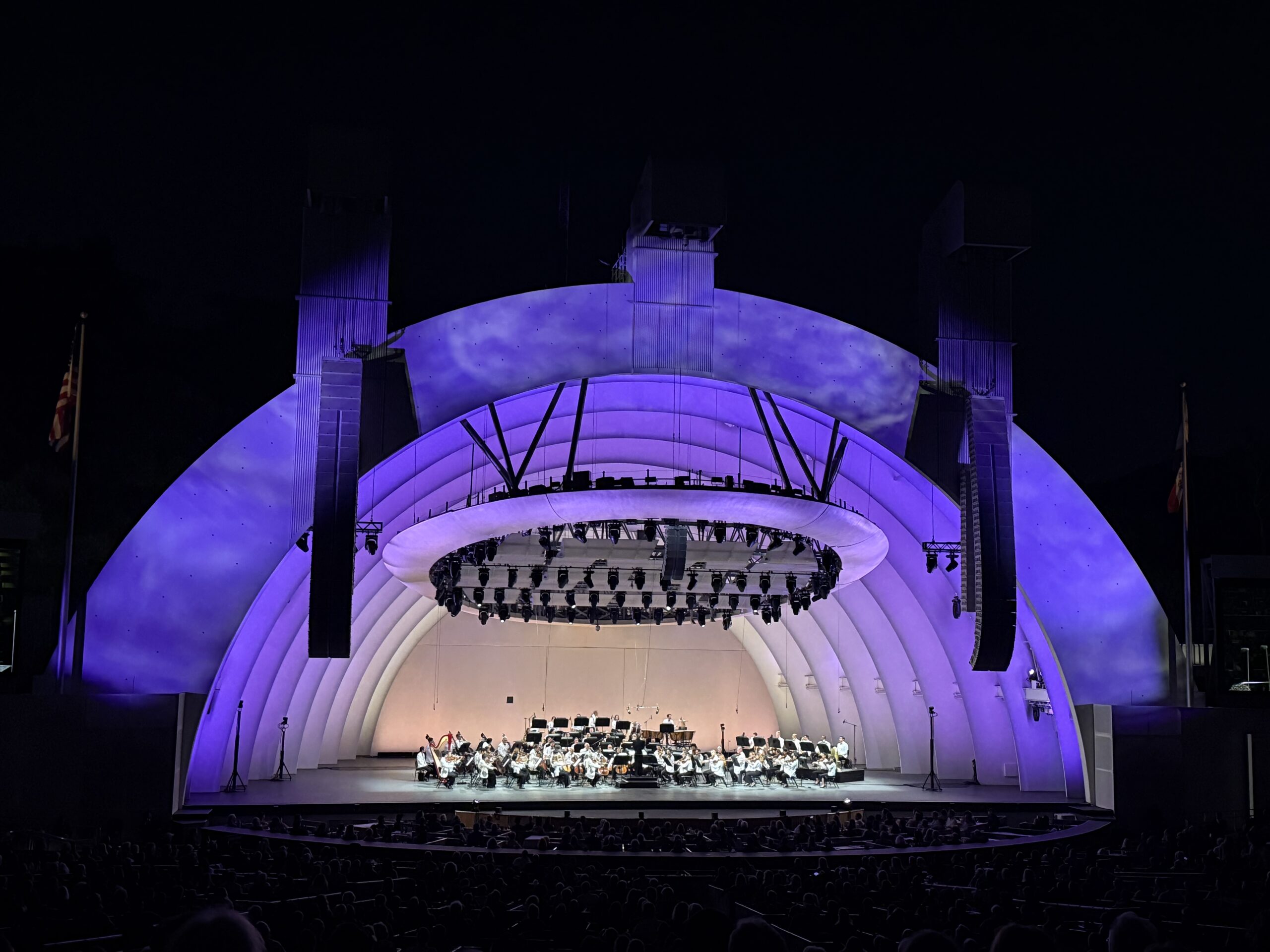By, Ioana Istrate, VIce President of Classical arts
Hollywoodland News
Listen, y’all. As an overworked, chronically underfunded music student who doesn’t get to go outside enough, Hollywood Bowl Summer concert season is my absolute favorite time of year.
For as little as a dollar per ticket (plus a park and ride shuttle pass, trust me), you can watch one of the world’s top orchestras perform gorgeous pieces while the sun sets over the hills. Cheap date, anyone? Seriously, pack a picnic, grab a wine cooler, and impress your Tinder date with a night at the symphony.

Brahms & Grieg: Big Hits and Even Bigger Energy
Brahms & Grieg was the perfect gal’s night for me. The LA Phil “played the hits” with crowd-pleasing, familiar symphonic selections. Conductor Tabita Berglund brought humor and energy to the podium, and soloist Hélène Grimaud owned the stage with presence and grace.

So consider the rest of this article your official call to action. Founder and Editor-In Chief of Hollywoodland News, Regina Luz Jordan and I clinked glasses of rosé while falling in love with music all over again. This program had romance, whimsy and drama—the full emotional range. You really don’t want to miss a night like this at the Bowl.
Let’s get into it.
Raisin Brahms
This was my second time reviewing Johannes Brahms’ (1833–1897) Piano Concerto No. 1 in D Minor for Hollywoodland News. You can catch my first review here.

Orchestras often program shorter works or premiere something new as an appetizer for big staples like this Brahms concerto. The last time I covered it, it closed the program. This time, the LA Phil came in hot and kicked things off with it.
Honestly, Brahms’ lush strings and dramatic, dense piano chords needed no warm-up. The orchestra opened with a theme that twisted and surged through both the ensemble and soloist across the movement. Through all that anticipation, anxiety and weight, a delicate piano motif finally emerged.

Soloist Hélène Grimaud didn’t crash through the orchestra’s sound. She gently nudged past it. Her entrance felt like the beginning of a conversation.
Grimaud is described in the program as a “Renaissance woman,” which is kind of underselling it. She’s worked with Daniel Barenboim, played Carnegie Hall, toured internationally, and performed with the San Francisco Symphony.
She also received the French Legion of Honour award (how many other pianists have earned national medals of honor?).
Oh—and she founded the Wolf Conservation Center in Salem, NY. International soloist. French national treasure. Wolf conservationist. This woman isn’t just a Renaissance woman. She’s a superhero.
And it’s that depth of experience that makes her artistry so refined. Brahms’ thick, stormy chords can easily turn plonky or heavy-handed. But Grimaud shaped melody out of walls of sound and carried a nuanced dialogue between piano and orchestra.
She’s also a humble queen. Before bowing to the audience’s full-throated standing ovation, she turned and acknowledged the orchestra with grace.

Brava, Hélène.
Peer Gynt, World’s Biggest D-bag
I have some things to say about Edvard Grieg’s Peer Gynt Suites, but nothing quite as colorful as Tabita Berglund’s introduction. But first, some context.

Peer Gynt is a Norwegian play written in 1867 by Henrik Ibsen. Ibsen fancied himself a poet, so the five-act play is written entirely in verse. It follows the completely self-inflicted and often fantastical misadventures of Norwegian peasant Peer Gynt.
Berglund described him best: “A bad egg. Not a nice man. Basically the biggest asshole alive.”
Grieg himself seemed to agree. According to a profile in Classical FM, he called the composition process “terribly unmanageable.” Fortunately, listening to his music is much more manageable.

Peer Gynt Suites No. 1 and No. 2 (Op. 46 and Op. 55) are selections from his larger body of incidental music for the play. The suites are often mixed, quoted or reshuffled, making them feel like a classical “choose your own adventure.”
Personally, I was delighted that the first real solo went to the violas.
In the Prelude, a rustic fiddle-style melody opens the piece with no accompaniment. The violist stands in as the village musician playing for a local wedding. It was joyful, earthy and completely unexpected.
Lights, Flutes and Bugs Bunny
Big shoutout to the light technicians at the Bowl because they absolutely brought the drama.
For the Brahms concerto, the iconic Hollywood Bowl stage lights bathed the orchestra in soft blue. For Peer Gynt, the lighting changed with each movement. Bright oranges and pinks lit up the stage during upbeat passages, while deep blues and reds set the tone for tense or dissonant moments.
At the top of Suite No. 2, during “The Abduction of the Bride,” the stage went completely dark. An eerie spotlight dropped onto the ensemble. It was chilling and cinematic, and the staging hit perfectly.
Now, you might be reading this and thinking, “Wow, I’ve never heard of this piece before. Sounds cool.” And honestly, you probably have heard it.
The whole concert perked up when “Morning Mood” started. Trust me, you know it. Go look it up real quick—you’ll say “oh yeah,” just like Regina did. A sweet flute and oboe exchange gently coaxes the sun to rise in the Moroccan desert. The moment blooms into a full orchestral glow.
You’ve definitely heard this one in Bugs Bunny, Soylent Green or The Simpsons. It’s iconic for a reason.
Grieg Deserved Better (and So Did I)
I don’t think I’ve ever taken the time to listen to the full Peer Gynt suites until now. Like I mentioned earlier, most performances just quote bits and pieces. I’d heard “Morning Mood” and “In the Hall of the Mountain King” a million times and never felt that excited about them.
That’s on me. I didn’t give Grieg enough credit.
Hearing the suites in full completely changed my perspective. Solveig’s Song in particular hit me like a ton of emotional bricks. It’s a heartbreaking, beautiful moment I wasn’t ready for. With the added context and Berglund’s interpretation, the work felt brand new.



Berglund is, in short, one of the most exciting conductors working today. Critics call her alert, charismatic and inspiring. I’d add “bold and fun as hell.” Even though she introduced Peer Gynt as “basically the biggest asshole alive,” she conducted his music with passion and precision.
I also love that the Bowl’s cameras gave us close-ups of her throughout the performance. Her expressive connection with the orchestra added a whole other layer to the experience.
The suites ended with the slow-burning, ominous march of In the Hall of the Mountain King. Here, Peer Gynt faces a mountain troll and spirals into chaos. Berglund took her time at the start, letting the orchestra stew in the tension. Then she ramped up the tempo until it was almost unhinged.
Most conductors play this part safe. Not Berglund. Her take felt risky in the best way, and the audience responded. People bobbed their heads, shifted in their seats and leapt to their feet the second it ended.
The standing ovation was instant. No one could resist it.
Final Thoughts
Regina, myself and the rest of the team at Hollywoodland News fully plan to live at the Bowl this summer.
Like I said earlier, it’s the perfect Hollywood night out. You really can’t find this kind of drama at this kind of price anymore. It’s giving broke girl luxury. It’s giving serotonin in symphonic form.
Honestly, just go. You won’t regret it.


Leave a Reply